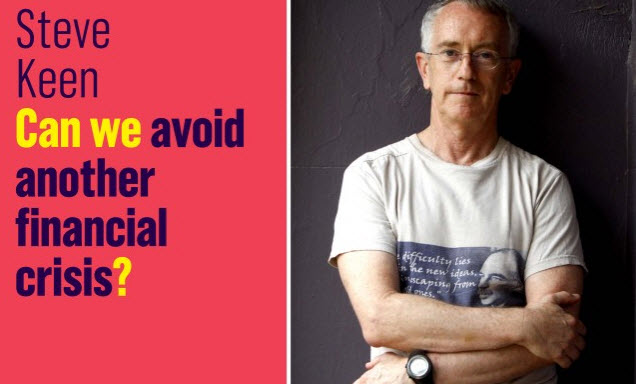Economist, Michael Hudson reviews Steve Keen’s ‘Can We Avoid Another Financial Crisis‘.

At first glance Steve Keen’s new book ‘Can We Avoid Another Financial Crisis’ seems too small-sized at 147 pages. But like a well-made atom-bomb, it is compactly designed for maximum reverberation to blow up its intended target.
Explaining why today’s debt residue has turned the United States, Britain and southern Europe into zombie economies, Steve Keen shows how ignoring debt the blind spot of neoliberal economics – basically the old neoclassical just-pretend view of the world. Neoclassical’s glib mathiness is a gloss for its unscientific “don’t worry about debt” message. Blame for today’s U.S., British and southern European inability to achieve economic recovery thus rests on the economic mainstream and its refusal to recognize that debt matters.
Mainstream models are unable to forecast or explain a depression. That is because depressions are essentially financial in character. The business cycle itself is a financial cycle – that is, a cycle of the buildup and collapse of debt.
Keen’s “Minsky” model traces this to what he has called “endogenous money creation,” that is, bank credit mainly to buyers of real estate, companies and other assets. He recently suggested a more catchy moniker: “Bank Originated Money and Debt” (BOMD). That seems easier to remember.
The concept is more accessible than the dry academic terminology usually coined. It is simple enough to show that the mathematics of compound interest lead the volume of debt to exceed the rate of GDP growth, thereby diverting more and more income to the financial sector as debt service. Keen traces this view back to Irving Fisher’s famous 1933 article on debt deflation – the residue from unpaid debt. Such payments to creditors leave less available to spend on goods and services.
In explaining the mathematical dynamics underlying his “Minsky” model, Keen links financial dynamics to employment. If private debt grows faster than GDP, the debt/GDP ratio will rise. This stifles markets, and hence employment. Wages fall as a share of GDP.
This is precisely what is happening. But mainstream models ignore the overgrowth of debt, as if the economy operates on a barter basis. Keen calls this “the barter illusion,” and reviews his wonderful exchange with Paul Krugman (who plays the role of an intellectual Bambi to Keen’s Godzilla). Krugman insists that banks do not create credit but merely recycle savings – as if they are savings banks, not commercial banks. It is the old logic that debt doesn’t matter because “we” owe the debt to “ourselves.”
The “We” are the 99%, the “ourselves” are the 1%. Krugman calls them “patient” savers vs “impatient” borrowers, blaming the malstructured economy on personal psychology of indebted victims having to work for a living and spend their working lives paying off the debt needed to obtain debt-leveraged homes of their own, debt-leveraged education and other basic living costs.
By being so compact, this book is able to concentrate attention on the easy-to-understand mathematical principles that underlie the “junk economics” mainstream. Keen explains why, mathematically, the Great Moderation leading up to the 2008 crash was not an anomaly, but is inherent in a basic principle: Economies can prolong the debt-financed boom and delay a crash simply by providing more and more credit, Australia-style. The effect is to make the ensuing crash worse, more long-lasting and more difficult to extricate. For this, he blames mainly Margaret Thatcher and Alan Greenspan as, in effect, bank lobbyists. But behind them is the whole edifice of neoliberal economic brainwashing.
Keen attacks this “neoclassical” methodology by pointing to the logical fallacy of trying to explain society by looking only at “the individual.” That approach and its related “series of plausible but false propositions” blinds economics graduates from seeing the obvious. Their discipline is the product of ideological desire not to blame banks or creditors, wrapped in a libertarian antagonism toward government’s role as economic regulator, money creator, and financier of basic infrastructure.
Keen’s exposition undercuts the most basic and fundamental assumptions of neoclassical (that is, anti-government, anti-socialist) economics by showing that instead of personifying economic classes as “individuals” (Krugman’s “prudent” individuals with their inherited fortunes and insider dealings vs. spendthrift individuals too economically squeezed to afford to buy houses free of mortgage debt), it is easier to start with basic economic categories – creditors, wage earners, employers, governments running deficits (to provide the economy with money) or surpluses (to suck out money and force reliance on commercial banks).
His Figure 16 shows how stable UK private debt/GDP was for a century, until Margaret Thatcher deranged the economy. Debt soared, and mainstream economists applauded the boom. (He suggests calling this new wave of neoliberal policy “deform,” in contrast to “reform.” We certainly need a new vocabulary to counter the soporific euphemisms used by the fake economic news media.) Privatization of Council Housing and basic infrastructure forced the population deeply into debt to afford their basic needs. The financial City of London ended up the big winners, while industry or labor have suffered a debt squeeze.
Keen’s model shows that a long debt buildup can give the appearance of prosperity, until the crash comes. But when it comes, voters blame the party in power, not the earlier promoters of nationwide debt peonage. Along with Thatcher, Keen places the blame on the pied piper of Wall Street deregulation Alan Greenspan, whom he calls “a maestro of delusion, not of insight.” He also cites Larry Summers as an example of the learned ignorance beclouding economic discussion – which of course is just why the Clintons and Obama were told by their Donor Class to anoint him.
This book enables the non-mathematician to pierce the shell of mathiness in which today’s economic mainstream wraps its lobbying effort for the big banks and their product, debt. The needed escape from the debt deflation they have caused is a debt writedown.
The problem is that the public is brainwashed to imagine that it is the banks that need saving, not the indebted economy. Keen proposes a “Modern Debt Jubilee” that is essentially a swap of equity for debt. The intellectual pedigree for this policy to keep debt within the ability to pay was laid two centuries ago by Saint-Simon in France. His solution was for banks to take an equity position in their clients, so that payments to backers could rise or fall in keeping with the fortunes of the enterprise. Keen urges that this become the basis for future banking.
As a transition from todays debt stagnation, he suggests that the central banks create a lump sum to put into everyone’s account. Debtors would be required to use their gift to pay down the debt. Non-debtors would keep the transfer payment – so as not to let demagogic political opponents accuse this plan of rewarding the profligate.
If this solution is not taken, debtors will continue to lumber on under debt and tax conditions where only about a third of their nominal wages are available to spend on the goods and services that labor produces. The circular flow between producers and consumers will shrink – being siphoned off by debt service and government taxes to bail out bankers instead of their victims.
This should be what today’s politics is all about. It should be the politics of the future. But that requires an Economics of the Future – that is, Reality Economics.
Toward this end, Keen’s book should be basic reading for placing debt at the center of today’s political debate and replacing mainstream “barter” economics with a more reality-based discipline.
Check out ‘Can We Avoid Another Financial Crisis’ for yourself, it is available on Book Depository, Amazon and other good-book retailers.

With workers pushed to breaking point, is it now time to call time on predatory business models?

Both COVID-19 and the climate crisis are being used as camouflage for central bankers to throw more printed money into a broken system.

With proper access to land denied to the vast majority, is it now time to reclassify trespass as a revolutionary act?